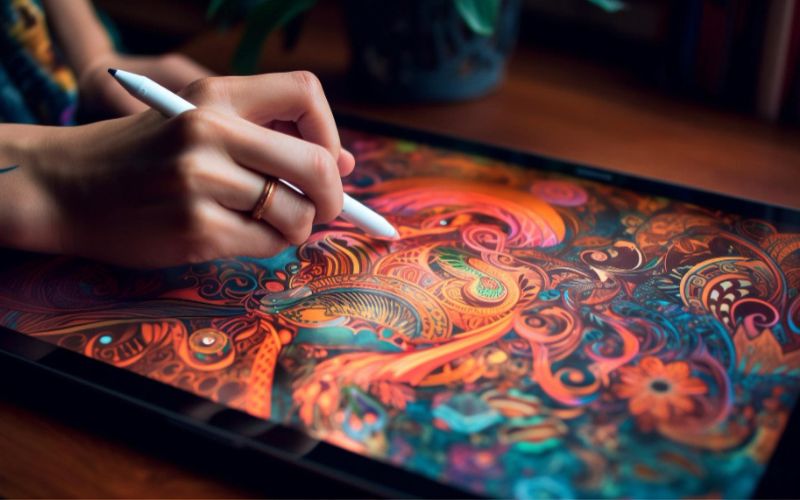A Complete Guide Of Graphic Designing Courses 2023
Table of Contents
# Benefits of A Graphic Designing Course
# Essential Design Principles Every Graphic Designer Should Know
# What’s More in Graphic Designing Course, Apart from Designing?
# Ways Graphic Design Courses Foster Creativity and Innovation in Students
# Ways Taught in Course to Gather Inspiration for Design Projects
# Are You Looking for The Best Graphic Designing Course in Kolkata?
# Conclusion
In today’s digital age, visual communication plays a critical role in conveying messages effectively and captivating audiences. Graphic design is the art of creating visually appealing graphics and layouts for various mediums such as print, web, and multimedia. It combines creativity, technical skills, and a keen understanding of design principles to produce stunning visuals that communicate ideas, emotions, and information.
If you have a passion for creativity and visual storytelling, pursuing a graphic designing course can be an excellent choice.
In this blog, we will cover a comprehensive guide of graphic designing.
Benefits of A Graphic Designing Course
- Developing a Strong Foundation:
A graphic designing course provides a comprehensive understanding of the principles and elements of design, equipping you with the knowledge and skills needed to create visually impactful designs. From color theory and typography to composition and layout, you will learn the fundamental concepts that form the backbone of effective visual communication.
- Mastering Industry-Standard Tools:
Proficiency in industry-standard graphic design software is a crucial skill for any aspiring designer. A graphic designing course typically includes training in popular software applications such as Adobe Photoshop, Illustrator, and InDesign. These tools enable you to bring your creative ideas to life, manipulate digital images, create vector illustrations, and design stunning layouts.
- Cultivating Creativity and Design Thinking:
Graphic design is an art form that requires a creative approach and an ability to think critically. A designing course encourages you to think outside the box, explore new ideas, experiment with different techniques, and develop a unique design style. Through hands-on projects and assignments, you will learn to unleash your creativity and apply design thinking to solve visual communication challenges.
- Building a Versatile Skill Set:
Graphic design is a versatile field that offers opportunities in various industries. Whether you are interested in branding and advertising, web and app design, publication design, or user experience (UX) design, a graphic designing course equips you with the skills needed to adapt to different design contexts. This versatility allows you to pursue a diverse range of career paths or work as a freelance designer, catering to a wide array of clients and projects.
Getting your graphic designing course done from a place where there is good faculty and experienced instructors and graphic designing courses in Kolkata can be a wise decision for you.
Essential Design Principles Every Graphic Designer Should Know
There are several essential design principles that every graphic designer should know. Here are some of them:
- Balance: Achieving visual equilibrium by distributing elements throughout the design in a way that creates harmony and stability.
- Contrast: Using contrasting elements such as colors, shapes, sizes, or typography to create visual interest and make certain elements stand out.
- Hierarchy: Establishing a clear order of importance and organizing elements in a way that guides the viewer’s attention and conveys the intended message effectively.
- Alignment: Ensuring that elements are visually connected and positioned in a way that creates a cohesive and balanced design.
- Proximity: Grouping related elements together to create visual relationships and establish organization in the design.
- Repetition: Repeating certain elements, such as colors, shapes, or patterns, throughout the design to create a sense of unity and reinforce the overall visual theme.
- Typography: Applying principles of typography for legibility, readability, and aesthetic appeal, including proper font choice, spacing, and hierarchy.
- Color theory: Understanding how colors interact, complement, and convey emotions to effectively utilize color palettes in designs.
- White space: Utilizing empty or negative spaces intentionally to create breathing room and enhance the overall visual impact of the design.
- Simplicity: Striving for simplicity and minimalism to ensure clarity and avoid overwhelming the viewer with excessive elements or visual clutter.
These principles can serve as foundational guidelines for creating visually appealing and effective designs. However, it’s important for designers to experiment and find a balance that works best for their specific projects and objectives.
What’s More in Graphic Designing Course, Apart from Designing?
Graphic design courses offer a wide range of valuable topics along with design principles, guiding students in areas like color theory, typography, composition, and software like Adobe Creative Suite. Historical and cultural aspects of graphic design are also explored along with branding, identity design, and user experience (UX) design principles.
Certain courses may also offer supplementary modules on print design, web design, motion graphics, packaging design, and marketing basics, enabling students to tackle diverse design challenges across mediums.
Overall, graphic design courses provide a comprehensive understanding of the discipline, enabling students to create visually stunning designs while nurturing their creative and technical skills.
Ways Graphic Design Courses Foster Creativity and Innovation in Students

Here are some ways in which graphic design courses foster creativity and innovation in students:
- Exposure to diverse design projects: Graphic design courses often provide students with a wide range of design projects, allowing them to explore different industries, mediums, and design challenges. This exposure encourages students to think creatively and come up with innovative solutions for each project.
- Emphasis on visual research and inspiration: Graphic design courses emphasize the importance of visual research and seeking inspiration from various sources. By exposing students to different design styles, art movements, and cultural influences, these courses inspire students to think creatively and incorporate unique elements into their designs.
- Encouragement of experimentation: Graphic design courses encourage students to experiment with different materials, techniques, and design tools. This experimentation fosters a spirit of exploration and allows students to discover new and innovative ways to solve design problems.
- Critical thinking skills: Graphic design courses teach students to analyze and evaluate design choices critically. Through design critiques and feedback sessions, students learn to assess their own work and the work of others, fostering a culture of constructive criticism and continuous improvement.
- Integration of technology and digital tools: Graphic design courses introduce students to industry-standard design software and digital tools. This exposure enhances students’ technical skills and empowers them to explore new possibilities and innovative techniques in their designs.
- Integration of real-world experiences: Graphic design courses often include real-world design projects, allowing students to apply their skills to practical scenarios. This integration of real-world experiences challenges students to think creatively and come up with innovative design solutions that meet the needs of clients or target audiences.
Ways Taught in Course to Gather Inspiration for Design Projects
Graphic design courses typically teach students various methods to gather inspiration for their design projects. Here are some common approaches:
- Research: Students are encouraged to research the subject matter of their project, whether it’s a product, concept, or theme. This research helps them gain a deeper understanding of the topic and identify relevant visual references.
- Mood boards: Creating mood boards with images, colors, textures, and typography that resonate with the project’s objectives can help students develop a visual direction and gather inspiration.
- Visual analysis: Students learn to critically analyze existing designs, advertisements, websites, and art to understand design principles, styles, and techniques that may inspire their work.
- Nature and surroundings: Often, nature, architecture, and the environment can serve as a rich source of inspiration for design elements like patterns, textures, and color palettes.
- Personal experiences: Designers often find inspiration in their own life experiences, emotions, and personal interests. Encouraging students to tap into their unique perspectives can lead to original and meaningful design concepts.
- Trend analysis: Staying up-to-date with current design trends and industry developments can help students understand what’s popular and relevant in their field.
- Creative exercises: Instructors may assign creative exercises such as mind mapping, brainstorming sessions, or word associations to stimulate ideas and gather inspiration.
Are You Looking for The Best Graphic Designing Course in Kolkata?
George Animatrix not only offers one of the best graphic design courses in Kolkata but also has the highest number of placements from the reputed multinational and international companies.
Conclusion
A graphic designing course offers a transformative learning experience, enabling individuals to develop their creative potential and acquire skills that are highly in demand in today’s communication-driven world. From building a strong foundation in design principles to mastering industry-standard tools, a course in graphic design equips you with the knowledge, confidence, and technical skills to create compelling visuals. By pursuing a graphic designing course, you can embark on a fulfilling career in the dynamic and ever-evolving field of graphic design.
Find your way to success at George Animation!


